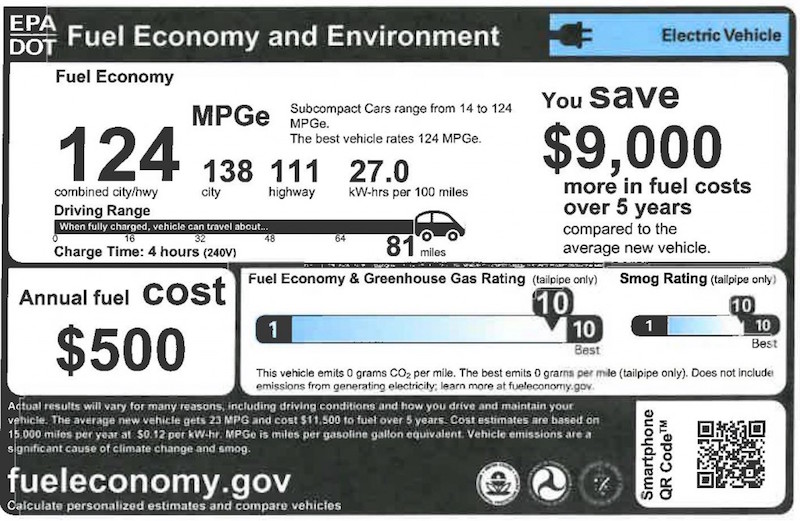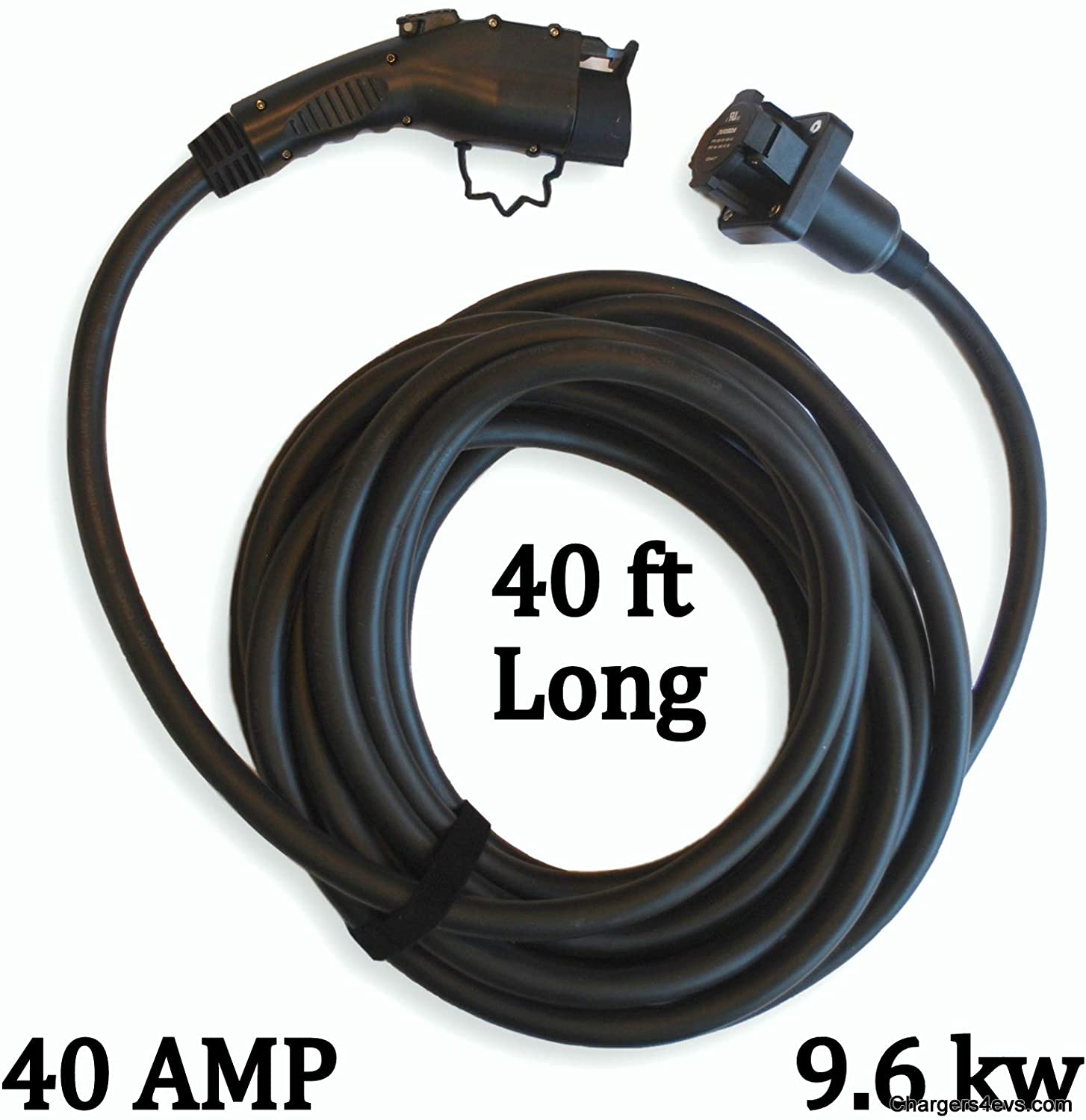Last Update: 2021-01-03T23:53:32.489Z

The so-called Monroney label is meant to inform buyers about energy efficiency statistics. For electric cars, the EPA developed a new Monroney label showing statistics suitable for electric vehicles.
Now that we’ve got some information under our belt, we can start to decode this sticker. It’s the official EPA information sticker used on electric cars, in this case the 2014 BMW i3, and shows a number of impacts and costs related to electric vehicle ownership.
Energy consumption per mile
You’ll note the 270 Wh/mile figure we listed elsewhere for the BMW i3 doesn’t appear on this sticker. Instead we see a figure of 27 kWh per 100 miles, but it’s a simple matter of division to convert that to 270 Wh/mile.
This number means the BMW i3 consumes 1 kiloWatt-Hour of electricity in a bit less than 4 miles. Since it has a 21 kiloWatt-hour battery pack, the car carries less than the 27 kiloWatt-hours required to travel 100 miles. We've already gone over how the EPA range is estimated. The first estimate is simply this division:
range = kWh in pack x miles/kWh
That would suggest the BMW i3's driving range is about 80 miles. For the BMW i3 the 270 Wh/mile is equal to 0.27 kWh/mile or 3.70 miles/kWh. Multiplying by 21 kWh we get 77.7777 miles range. But, wait you say, the EPA rates the BMW i3 to have an 81 mile range. How come they came up with a bigger number?
The EPA range estimate is more comprehensive than the simplistic calculation we just did. For more on this see the previous section: How does EPA estimate electric car driving range?
The EPA test cycle runs the car at a mix of different speeds over a test to emulate a representative mix of highway and city driving. The simple calculation above gets us into the right ballpark of range estimation, and the EPA's methods gets us to the right row of the ballpark.
Emissions ratings, and tailpipe or non-tailpipe emissions
The smog rating and greenhouse gas rating shown on the sticker is pegged at 10 (best). In the fine print the i3 is said to emit 0 grams of CO2 per mile, and that the measurement is at the tailpipe only, which is a very important distinction.
That’s great, because it means electric cars have no climate change impact. But… we have to discuss the fine print.
To measure tailpipe tailpipe emissions, or to measure emissions at the power plant. That's the crux of one of the arguments about electric cars. Those who deride EV's as "coal powered" or hauling a coal tender behind them, they're making the argument emissions should be measured at the power plant.
Should electric vehicle owners hang their heads in shame over buying into the “that electric cars are clean” scam? Not so fast.
It is true that ones electricity is only as clean as the power plant it came from, [CleanElectricity] and those whose electricity comes from a coal plant have dirty electricity. At the same time old dirty power plants are being retired all the time and are replaced with new highly efficient cleaner power plants. That means the electricity mix in the U.S. and elsewhere is getting cleaner every year. Meaning that over time the electricity powering electric cars is getting cleaner.
To rely just on "electricity is getting cleaner" doesn't address the real issue. Do we measure at the tailpipe or at the power plant? And, in the case of gasoline powered cars, where is their equivalent to the power plant?
Gasoline doesn't form out of thin air any more than does electricity. Wait, solar power does sorta form out of thin air, so long as you have the right gizmos to capture solar energy. The point is that extracting gasoline from crude oil, and extracting crude oil from the ground, is an extremely messy business. I have extensive documentation of how messy the fossil fuel business is, elsewhere. [FossilFuelStory]
To measure only tailpipe emissions for gasoline cars would be just as misleading as it is to measure only tailpipe emissions from electric cars. In both cases we're missing a huge chunk of emissions from the industrial processes that create gasoline or electricity.
Think about all the oil spills, the side effects from fracking, and all the other negative effects all of us are suffering thanks to the oil industry and its practices. Yes, we need to pay attention to how dirty or clean our electricity supply is.
Doesn't what the EPA does - to measure emissions only at the tailpipe - punt on the real problem? Namely, the whole system is slowly poisoning us all, and heating the climate/environment at an alarming rate. So long as we don't measure or report on the whole emissions, those problems will not be solved.
On the other hand, adding in emissions from the fuel refining process, or the electricity generating process, would immensely complicate the emissions reporting on this sticker. The system delivering gasoline to the corner gas station is immensely complex and resource intensive, as is the system delivering electricity to the power outlet. The actual impact depends on the actual source of the crude oil or the electricity. We go into this in greater detail while examining the false "coal powered electric car" myth. [CoalPoweredEV]
The EPA label measures emissions as Grams of CO2 emitted at the tailpipe. The EPA does this for any vehicle, whether it runs on gasoline, diesel or electricity. For better or for worse this is a simplification of a hugely complex problem. That hugely complex story is being swept under the rug.
Fuel cost savings
The fuel cost savings and annual fuel cost are, of course, an estimate based on average fuel prices and average miles driven per year. As it says on the sticker, the reference is a 23 MPG gasoline vehicle driven 15,000 miles a year at a cost of $11,500 for the gasoline over five years, or $2,300 per year. The electricity cost in this case, $500 per year, is based on the same 15,000 miles per year and an average electricity cost of $0.12 per kiloWatt-hour. That means $1,800 per year in fuel cost savings, on average.
As we saw in A brief study of EV Ownership Economics, electricity used as a fuel is cheaper than gasoline. It’s enough cheaper to pay for the price premium over an equivalent gasoline car over the typical ownership period, if you drive enough, and if gasoline prices stay high. [FuelCost] [EVEconomics]
In this case the BMW i3 is projected to save $9,000 in fuel cost over 5 years. That combined with tax incentives and other cost of ownership savings can add up to paying for a large price premium.
MPGe, or equating kiloWatt-hours with gallons of gasoline
The last section on the Monroney label is the miles per gallon equivalent (MPGe) rating we’ve been dancing around for awhile. Electricity and gasoline are measured in completely different ways – kiloWatt-hours versus gallons. That begs the question on how the EPA can determine an MPGe rating on electric cars when their fuel isn’t measured by gallons.
The trick is in that “e” appended to the rating, referring to the word “equivalent”.
The natural measure for electric vehicle energy consumption is the kiloWatt-hours per 100 miles (or Watt-hours per mile) rating we’ve already discussed. But we’re accustomed to gallons of gasoline and comparing MPG ratings between gasoline cars. How do we compare fuel efficiency between a 35 MPG gasoline car to a 230 Wh/mile electric car?
Through focus group activities the EPA decided it would be better to tell electric car buyers an MPG-like number to compare with MPG ratings on gasoline cars. Behold, the MPGe.
The methodology is called “gallons gasoline equivalent,” a comparison method the EPA had already developed. The GGE lets one compare various fuels based on the energy content. Burning one gallon of gasoline releases 115,000 BTU’s of energy, Diesel releases 129,488 BTU’s per gallon, biodiesel releases 119,550 BTU’s per gallon, ethanol releases 76,330 BTU’s per gallon, and so forth. The energy content of 1 kiloWatt-hour is 3,412 BTU. With some calculation one can calculate the quantity of a fuel required to release 115,000 BTU’s of energy, giving us the gallons gasoline equivalent for that fuel.
The MPGe rating calculation is total miles driven times energy of one gallon of gasoline divided by energy content of all fuels consumed. The mathematicians can puzzle through what that means on their own. Let’s instead talk about what it means.
The bottom line is the EPA considers 33.7 kiloWatt-hours of electricity to be equivalent to 1 gallon of gasoline. Let’s make it clear that this sort of comparison is imprecise, and indeed the actual equivalence varies from agency to agency. The California Air Resources Board uses a different methodology and its conversion factor is 32.6 kiloWatt-hours to 1 gallon of gasoline.
This means that the Nissan Leaf with its 24 kiloWatt-hour battery pack is carrying the energy equivalent of 0.71 gallons of gasoline. With that small amount of energy it can travel 80 miles or so. That miraculous feat, similar perhaps to when Jesus fed a mountain full of people with a few fish and loaves of bread, rests on the inherent efficiency of electric drive trains.
eGallons
In July 2013, the US Dept of Energy unveiled a new measurement, the eGallon. It tries to present the fuel cost to drive electric or gasoline cars. The flawed presentation on the Dept of Energy website didn’t do a good job showing what could be a useful tool for comparing fuel costs of various vehicles.
Here’s the formula:
eGallon ($/gal) = (miles/gallon gasoline) * (kWh/mile) * ($/kWh)
Using some national averages, the DoE eGallon site showed an eGallon number calculated this way:
28.2 mi/gal * .35 kWh/mi * .1233 $/kWh = $1.22/gal
While that’s interesting, the calculation offers a way to compare any gasoline car to any electric car. Simply plug in the MPG rating for the gasser vehicle, the kWh/mile for the electric, and your local electricity rate, and you get an eGallon figure. But then the question is whether this calculation of any use?




